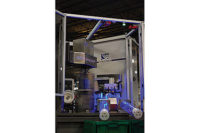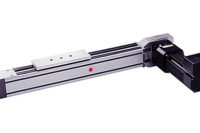Linear motor pallet-transfer systems have been around for more than a decade. What was once a cutting-edge technology is now available in a variety of different models and configurations. New developments in mechatronics, networking and software are amplifying the unique benefits of these systems. And, companies that pioneered the technology, like ATS Automation and MagneMotion Inc., suddenly have some competition.
“We welcome the competition,” says Peter Mattila, vice president of sales and marketing at MagneMotion. “We’ve been selling our linear synchronous motor systems for some time. In the past, people hesitated to adopt something new. But the fact that there’s emerging competition really bodes well. Linear motor transport systems are becoming more mainstream.”
In general, linear motor transfer systems work on the principle of a “smart” track—consisting of multiple linear servomotors—and a “dumb” mover outfitted with powerful magnets. Coordinating the activation of electromagnetic coils in the motors propels the movers around the track.
Albert Kleinikkink, P.Eng, director of product development at ATS Automation, says manufacturers are increasingly recognizing the advantages of linear motor transfer systems.
Topping that list is speed. “A fast pallet index has the obvious advantage that automation spends less time transferring product between stations, [creating] more time to perform operations,” says Kleinikkink, whose company introduced the SuperTrak linear motor conveyor back in 2001.
Precise control of acceleration and deceleration of the pallets is another benefit.
“With the typical station spacing used on the SuperTrak conveyor, pallets don’t tend to reach full speed between stations, and pallet index time is determined by acceleration and deceleration,” says Kleinikkink. “It is also important that pallets stop at precise locations immediately, so the automation working on the pallet can start right away. If the pallet takes time to settle into a precise location, the overall index time is compromised.
“In the case of the SuperTrak conveyor, every pallet has its own independent speed, acceleration and stopping location. Say the parts on the pallet were ‘tippy’ during a portion of the assembly process; the pallets could be programmed to move with the optimal speed, acceleration, and move profile to perform this specific transfer as fast as possible without dislodging parts.”
Such precise control over pallet motion also helps with optimizing processes such as vision inspection, printing, labeling and curing adhesives.
A third benefit of linear motor transfer systems is their ability to provide independent control over individual pallets. Traditionally, high-speed indexing chassis move carriers on a fixed pitch at a fixed cycle time. With these systems, all stations operate at the same cycle time.
Linear motor conveyors break this paradigm, giving each pallet its own independent speed, acceleration and trajectory. This lets assemblers move unloaded pallets at top speed and acceleration, which helps reduce cycle time. It also enables flexible pitching, in which different stations can work on parts one at a time, two at a time—or any multiple—depending on the process.
“With flexible pitching, each station can be designed for the optimal cycle time, not forced to operate at a single fixed cycle time,” explains Kleinikkink. “With flexible pitching, the automation is utilized more effectively, which leads to fewer pallets, fewer stations or fewer assembly lines.”
MagneMotion’s Mattila says the benefits of linear motor transfer systems are real and quantifiable. He points to an auto parts manufacturer that recently swapped its legacy pallet-transfer conveyor with his company’s MagneMover LITE for production of a small sensor.
“This switch to a linear motor-based system reduced the need for the external sensors, pop-up stops, pneumatic plumbing, large numbers of I/O modules and associated power supplies, cables and connectors associated with the incumbent system,” he says.
Ultimately, the manufacturer saved 30 percent in floor space, lowered power consumption by 50 percent, and reduced cycle time from 10 seconds to 3 seconds, Mattila says.
SuperTrak Conveyor
Now in its second generation, the SuperTrak conveyor can be built in lengths of up to 40 meters. Motion parameters for each pallet—direction, acceleration, speed and position—can be programmed individually. Integrated collision avoidance eliminates pallet-to-pallet contact and provides automatic queuing at process stations. Pallet routing can be controlled on a station-by-station basis or by means of individual pallet routing data.
Because a pallet can move back and forth independently, it can act as an axis of movement for operations such as dispensing, contouring and printing. Pallets can even be synchronized with external devices for continuous motion applications.
The width of the pallet ranges from 150 to 450 millimeters and the pallet and its payload can weigh up to 6 kilograms. Polymer rollers on steel tracks reduce pallet wear and keep the system clean. (The system meets ISO Class 6 clean room requirements.) Assembly stations can access the pallet from both the top and bottom.
Pallets can move at a maximum speed of 2.5 meters per second. Maximum acceleration at full load is 8.3 meters per second squared. Stop repeatability is ±0.051 millimeter.
Integrated pallet identification and tracking means that external RFID tags are not required. Absolute pallet identification tracking can be achieved using an optional integrated infrared system.
The third generation of the SuperTrak conveyor is scheduled to be released this year. According to Kleinikkink, it will deliver higher throughput, be more precise and be able to carry higher payloads. It will have a modernized and flexible PLC interface and be able to withstand washdowns.
MagneMover
MagneMotion’s QuickStick linear motor transport system has been around since 2001. This modular system lets engineers assemble linear tracks in increments of 1 or 0.5 meter. Modules are placed end-to-end to create a linear system that can be retrofit to an existing assembly process or serve as a platform for an entirely new line.
The QuickStick HT is for high-thrust, high-speed applications. It can handle payloads of up to 4,500 kilograms. Maximum speed is 2.5 meters per second and maximum acceleration is 4 g, depending on the load. The system can accommodate up to two movers per meter of track. Positional repeatability is ±1 millimeter.
The QuickStick 100 is for small and medium loads. It can handle payloads of up to 100 kilograms. Maximum speed is 2.5 meters per second and maximum acceleration is 1 g. It can handle up to five movers per meter of track, depending on the mover’s magnet array. With calibration, positional repeatability of ±0.1 millimeter is attainable.
Magnemotion’s most recent linear transport product is the MagneMover Lite.
“Five years ago, we started to see growing demand for moving smaller, lighter loads…so we developed the MagneMover Lite,” says Mattila. “It’s now become our flagship product. We wanted a system that was like a model train set, in which you could snap the pieces together in any order to create endless different layouts.”
Instead of large pallets, the MagneMover Lite moves pucks that are 60 millimeters square. Each puck can carry a 1 kilogram payload. Pucks are available in single and tandem versions. Up to nine pucks can be in motion per meter of track, and up to 12 can sit in a queue.
Straight sections are available in lengths of 1 and 0.25 meter. Left and right switches, and 90- and 180-degree curves are also available.
Maximum speed is 2 meters per second and maximum acceleration is 0.2 g. Positional repeatability is ±0.5 millimeter or up to ±0.1 millimeter at process stations in the direction of motion.
An IP 65-rated version is available for applications requiring washdowns.
iTRAK
The iTRAK from Jacobs Automation (now a part of Rockwell Automation) provides independent control of multiple movers on straight, curved or curvilinear tracks.
Like MagneMotion’s conveyors, the system is modular. Curved and linear modules can be combined to create systems of any length or shape. The system can be deployed in oval, square, rectangular, or linear configurations. The tracks can be horizontal (parallel to the floor) or vertical (perpendicular to the floor). They can even be mounted to a wall.
Each curved and linear module is a self-contained, multiphase linear motor. Only a power supply and EtherNet/IP connection are required. Energizing one or more the 12 electromagnetic coils within the module engages a magnet plate on the mover, propelling it forward or backward around the track.
Linear modules are 400 millimeters long. Curved modules have a 254 millimeter radius. Both come in widths of 50, 100 or 150 millimeters. The optimal width depends on the speed, payload and acceleration requirements of the application.
The motion of the mover is tracked using an absolute encoder integrated within each motor module. This allows for a cold start of the system without the need for homing. Movers can achieve a top speed of 7 meters per second and a maximum acceleration of 10 g. Each mover can be positioned with a repeatability of ±50 microns.
Movers are available in high-speed and low-speed models. The high-speed mover is for applications requiring speeds above 2 meters per second. Designed for high precision movement and placement, the high-speed mover must be used with a bearing rail system.
The low-speed mover is for applications requiring point-to-point movements and for speeds below 2 meters per second. It does not require a bearing rail system.
The iTRAK system has a distributed power and control architecture. Each module contains its own servo drive, which requires power and communications. A power and control module (PCM) provides these functions in a centralized unit. Each PCM consists of a DC bus power supply and the option to house a gateway module. The bus provides power to multiple modules via a daisy-chained power cable. The gateway provides communications support to each module via a separate communications cable.
XTS—Extended Transport System
The XTS extended transport system from Beckhoff Automation LLC is also built from modular linear servomotors in straight and curved configurations. Each module is self-contained, including the coils, drive and encoder. The only additional requirements are a power supply and an EtherCAT connection.
Straight and curved sections can be combined arbitrarily. Theoretically, there’s no limit to how long a system can be, but computing power typically limits the length to around 10 meters.
The motors provide independent control of multiple wireless movers, which ride on a hard, anodized aluminum guide rail. Made of aluminium, each mover is 55 millimeters long and weighs just 12 ounces without tooling or other attachments. Six rollers provide backlash-free travel on the straights and in the curves. A plastic coating on the rollers ensures quiet operation and low wear.
The mover is equipped with 22 magnetic plates. The attractive forces of the magnetic plates are largely balanced by their opposed arrangement, so the rollers and rail do not have to absorb the comparatively high attractive forces of the magnets.
An encoder flag on the mover supplies a position signal to the motor module. Movers can be distinguished from each other by their flags. The flag is made from a lightweight fiberglass-reinforced material. At a speed of 1.5 meters per second, movers can be positioned with an accuracy of ±0.25 millimeter. Repeatability is ±10 microns.
Movers can accelerate, brake, position and synchronize themselves. They can move to specific locations or they can move to positions relative to each other. They can group themselves and accumulate. They can even create clamping forces in motion. With a 48 VDC power supply, movers can hit a top speed of 4 meters per second.
Movers can be removed or installed on the guide rail without tools. The rails are available in lengths of up to 6 meters. Lubrication of the system is not necessary.
ASSEMBLY ONLINE
For more information on conveyors and indexing systems, visit www.assemblymag.com to read these articles:












